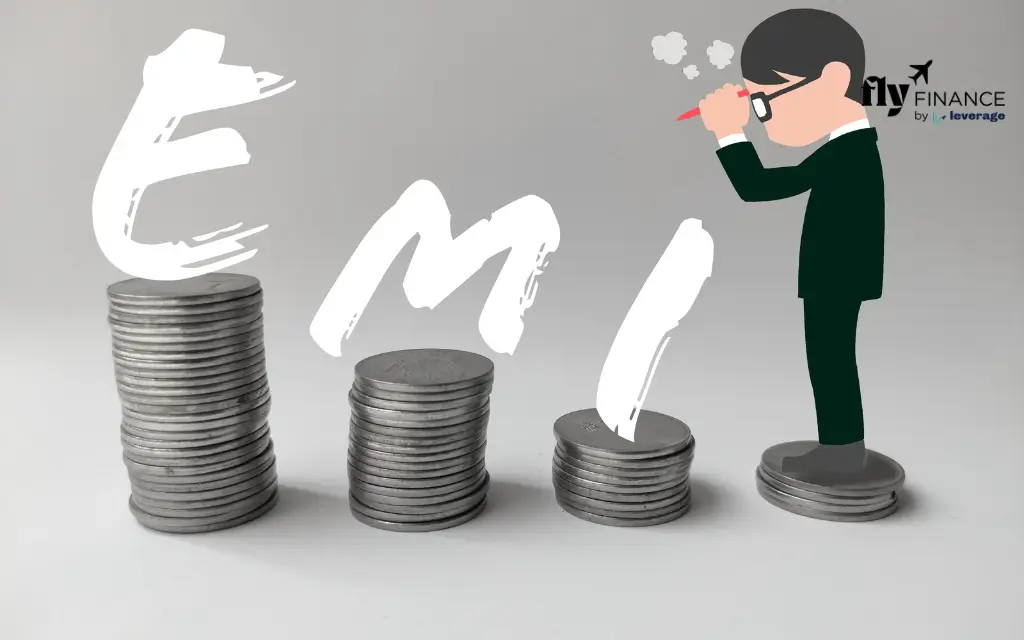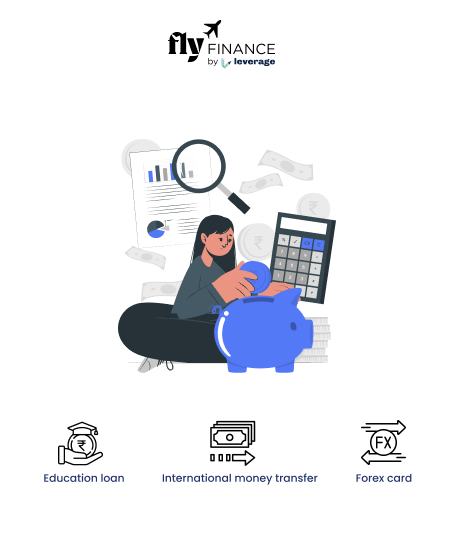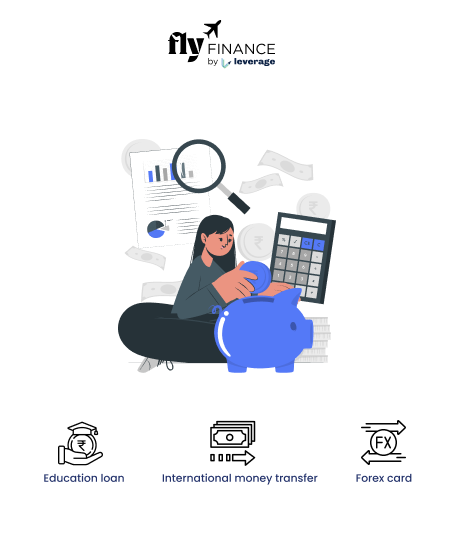EMI Full Form: The full form of EMI is Equated Monthly Instalments and it is one the most convenient ways to repay your loans. You must have heard of the term EMI in banking. Do you what exactly it means? Saving you from undue financial strain, EMIs can help you finance everything from your smartwatch to your study-abroad educational pursuits. Instead of paying for them in lumpsum, one can choose to pay in equal instalments.
Equated Monthly Installments (EMIs) provide several advantages, making borrowing more accessible and manageable for individuals. Knowing all about the details of this financial term and its working helps in hassle-free financial management. Let’s know all about the EMI full form, its significance, components, working, calculation and everything else.
Table of contents
What is the Full Form of EMI?
EMI full form is Equated Monthly Installments. As the name suggests, these are the fixed equal payments made by the borrower to the lender every month at the specified date. When an individual takes a loan (personal loan, house loan, or education loan), the repayment is made in parts. EMI helps them to cover the initial amount of the loan, called the principal along with the interest due.
The major loan amount is divided into smaller amounts that must be paid back at regular intervals. Thus, EMI helps in relieving the undue financial strain.
Also Read: Know about the most inclusive LGBTQ+ scholarships all around the world. Explore various options that can be availed in the USA, Australia, New Zealand, the UK and Canada.
What is EMI?
EMI is a systematic way of repaying a loan through fixed monthly payments over a specified period. The EMI amount remains constant throughout the tenure (in the case of fixed-rate loans), making it easier for borrowers to budget their finances.
EMIs follow an amortization schedule, where a higher portion of the initial payments covers interest, while later installments contribute more towards the principal repayment. Over time, this ensures that the borrower gradually reduces their debt while paying consistent EMIs.
Each EMI consists of:
- Principal Component – The portion of the loan amount repaid each month.
- Interest Component – The lender’s charge on the borrowed amount, calculated as per the agreed interest rate.
Types of EMI
EMIs (Equated Monthly Installments) can be structured in different ways depending on the type of loan and the borrower’s financial needs. While most people associate EMIs with fixed monthly payments, various EMI models cater to different financial situations. Here are the major types of EMI structures:
The following table provides a clear comparison of EMI types based on their structure and best use cases:
| Type of EMI | Definition | How It Works | Best For |
|---|---|---|---|
| Fixed EMI | EMI remains constant throughout the tenure. | Higher interest paid initially, principal repayment increases over time. | Home loans, car loans, personal loans. |
| Reducing Balance EMI | Interest is charged on the outstanding principal, reducing EMI over time. | EMI decreases as interest reduces with a declining principal. | Home loans, business loans. |
| Step-Up EMI | EMI starts low and increases periodically. | EMI increases annually based on a fixed schedule. | Young professionals, long-term home loans. |
| Step-Down EMI | EMI starts high and decreases over time. | EMI reduces as loan tenure progresses. | Business owners, borrowers nearing retirement. |
| Balloon EMI | Low EMI throughout the tenure with a large final payment. | Borrowers pay small EMIs and a lump sum at the end. | Business loans, auto loans. |
| No-Cost EMI | Borrower pays only the principal, with interest covered by the seller or lender. | The product price is divided into equal installments without extra cost. | Consumer electronics, e-commerce purchases. |
| Pre-EMI | Only interest is paid until full loan disbursement. | Borrower pays interest on disbursed loan amounts, and EMI starts after full loan sanction. | Home loans for under-construction properties. |
Features and Significance of EMI
Choosing the right EMI type depends on income stability, future financial goals, and the loan’s purpose. Let’s have a look at the main features and significance of choosing EMI as the repayment option.
- They are equal amounts of instalments paid at a specified date of every month.
- EMIs provide a structured way of loan repayment.
- It provides transparency to the borrowers on how much amount is to be paid monthly.
- EMIs are a flexible repayment option that can be customised and restructured as per the borrower’s needs.
- EMIs are an affordable option for availing the benefits of the loaned-out asset and paying for it in upcoming years.
- Timely EMI payments help an individual improve their credit score.
- Income Tax rebate under section 80E of the Income Tax Act is applicable to certain kinds of loans like education loans.
How Does Equated Monthly Installment (EMI) Work?
The concept of EMI (full form is Equated Monthly Instalments) was introduced understanding that it might get challenging for an individual to repay huge amounts of funds taken to finance personal, housing, or educational dreams. To make the repayment easier, two major components- the principal amount and the interest amount were added to the monthly instalments.
- The principal amount refers to the actual loan amount received by the borrower. (For example- if an education loan of INR 60 lakhs is availed, then 60 lakhs is the principal amount).
- The interest amount is the cost incurred by the borrower to utilise the principal amount. For example- on an education loan of INR 60 lakhs, if the monthly instalment is INR 55 thousand, then it will have an inclusion of interest amount based on the interest rate calculation).
The borrowers agree to pay the principal amount + interest amount in equal monthly instalments. The repayment loan tenure ranges from months to years based on the loan amount and borrower’s need. Initial EMI payments include a maximum amount towards interest payments. Over the years, the proportion allocated to interest decreases and the portion of the principal amount increases. Finally, timely EMI payments ensure repayment of the loan availed.
Also Read: Want to know about the minimum family income needed to avail of study abroad education loans? Check out all the details on minimum family income requirements for education loans.
EMIs Calculations
Equated Monthly Instalments (EMI full form) are calculated using the formula:
[P × R × (1+R)^N] / [(1+R)^N-1]
The formula takes loan tenure, interest rate and the loan amount into consideration for EMI calculation. Here, P stands for the principal amount, R stands for the monthly rate of interest (annual interest rate divided by 12), and N stands for the number of monthly instalments.
Example of EMI Calculation:
Let’s take an example to understand the EMI calculation in the following situation- Ram took an education loan of INR 50 lakhs at 9% p.a for 15 years. Now,
P= 50 lakhs
N= 15 years
R= 9/12/100 = 0.0075
EMI= [P × R × (1+R)^N] / [(1+R)^N-1]
50,00,000 * 0.075 * (1 + 0.0075)150 / ((1 + 0.0075)150 – 1) = INR 50,713.
Thus, based on the above formula and calculation, the following is the result of EMI calculation-
| Monthly EMI | INR 50,713 |
| Principal amount | INR 50,00,000 |
| Total interest | INR 41,28,399 |
| Total amount | INR 91,28,399 |
You can simply use the EMI Calculator and save yourself from the hassles of complex calculations.
Also Read: Check about the Education Loan EMI Calculator with or without the moratorium period and determine the significance and functioning of the same.
Factors Affecting Equated Monthly Instalments Payments?
As discussed, Equated Monthly Instalment (full form of EMI) calculation is based on the principal amount, interest rate and loan tenure. These are the major factors that influence EMI payments. The higher amounts of loan amount, interest rates and loan tenure result in higher Equated Monthly Instalments. Other factors that affect EMI payments are down payments and credit scores. Let’s have a look at these factors in detail-
- Principal Amount- If the borrower has taken a higher loan amount, the amount of the monthly instalment will also be higher.
- Interest Rate- Loans availed at high interest rates automatically lead to higher EMIs. Make sure to compare the lenders and choose one that offers loans at competitive rates of interest.
- Loan Tenure- Longer duration of repayment can result in smaller EMIs. However, this affects the overall interest costs (making them go higher).
- Down Payment- Down Payment refers to the amount of initial payment when purchasing anything on credit. Larger down payments result in lower EMIs or Equated Monthly Instalments.
- Credit Score- A good credit score often leads to loans at lower interest rates. This affects the overall EMI calculation.
FAQs on EMI Full Form
EMI stands for Equated Monthly Installments which is one of the most convenient ways to start making repayments of education loans, home loans, personal loans or others.
EMI payments save borrowers from undue financial strains by making equal monthly instalments over a specified period. These payments are to be made on a fixed date of every month, and the timely payments help in improving the credit score. Also, the interest amount paid on the EMIs of education loans is subject to an income tax rebate under Section 80E of the Income Tax Act.
On missing the EMI payments, the borrowers have to pay penalties to the lender, irrespective of the reasons. The penalty is based on the loan terms and conditions. Make sure to not miss any EMIs as it can severely affect the credit score and history.
The major factors that influence EMI payments are the principal amount, interest rate and loan tenure. The higher amounts of loan amount, interest rates and loan tenure result in higher Equated Monthly Instalments. Other factors that affect EMI payments are down payments and credit scores.
EMIs are calculated using the formula [P × R × (1+R)^N] / [(1+R)^N-1]. The formula takes loan tenure, interest rate and the loan amount into consideration for EMI calculation. If you have taken an education loan of INR 50 lakhs at 9% p.a for 15 years, the EMI will be INR 50,713 according to the formula.
EMI payments are simple and convenient ways of repaying a loan or repaying for a thing bought on a credit. Borrowers have to simply pay the fixed equal amounts every month at a specified date till the amount is completely paid off.
ईएमआई फुल फॉर्म है समान मासिक किस्त।
This was all about the full form of EMI and its benefits, working, and calculation. Make sure to read all the terms and conditions before choosing this convenient way of loan repayment.
Related Blogs
Follow Us on Social Media





























